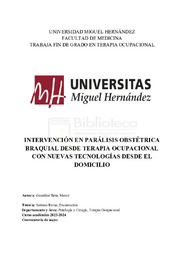Please use this identifier to cite or link to this item:
https://hdl.handle.net/11000/33113Full metadata record
| DC Field | Value | Language |
|---|---|---|
| dc.contributor.advisor | Serrano Reina, Encarnación | - |
| dc.contributor.author | González Beta, Mercé | - |
| dc.contributor.other | Departamentos de la UMH::Patología y Cirugía | es_ES |
| dc.date.accessioned | 2024-09-13T11:45:24Z | - |
| dc.date.available | 2024-09-13T11:45:24Z | - |
| dc.date.created | 2024-04-24 | - |
| dc.identifier.uri | https://hdl.handle.net/11000/33113 | - |
| dc.description.abstract | La parálisis obstétrica braquial (PBO), que provoca pérdida de movilidad voluntaria, es una de las complicaciones que pueden surgir en el parto, con una incidencia de 1,5-2 por cada 1000 nacimientos en España entre 2017 y 2020. El tratamiento de la PBO incluye opciones quirúrgicas seguidas de rehabilitación. El uso de dispositivos tecnológicos, como la robótica y Tablet, se ha mostrado efectivo para mejorar la recuperación funcional y la destreza manual en niños y adolescentes afectados. El paciente padece PBO de Erb-Duchenne izquierda. Durante la intervención se han realizado actividades con nuevas tecnologías, utilizando la Wii, el Makey Makey y aplicaciones para Tablet. El enfoque en nuevas tecnologías y la combinación con actividades al aire libre fueron clave para mantener la motivación del paciente y fomentar su compromiso en el proceso de rehabilitación. Aunque el uso de estas tecnologías requiere recursos adicionales, los beneficios en la motivación y el compromiso del paciente sugieren que su incorporación en futuras intervenciones sería recomendable. | es_ES |
| dc.description.abstract | The brachial obstetric palsy (PBO), which causes loss of voluntary mobility, is one of the complications that can arise during childbirth, with an incidence of 1.5-2 per 1000 births in Spain between 2017 and 2020. Treatment for PBO includes surgical options followed by rehabilitation. The use of technological devices, such as robotics and tablets, has been shown to be effective in improving functional recovery and manual dexterity in affected children and adolescents. The patient suffers from left Erb-Duchenne PBO. During the intervention, activities with new technologies were carried out, using the Wii, the Makey Makey, and tablet applications. The focus on new technologies and the combination with outdoor activities were key to maintaining the patient's motivation and fostering their commitment to the rehabilitation process. Although the use of these technologies requires additional resources, the benefits in patient motivation and commitment suggest that their incorporation into future interventions would be advisable. | es_ES |
| dc.format | application/pdf | es_ES |
| dc.format.extent | 37 | es_ES |
| dc.language.iso | spa | es_ES |
| dc.publisher | Universidad Miguel Hernández | es_ES |
| dc.rights | info:eu-repo/semantics/openAccess | es_ES |
| dc.rights.uri | http://creativecommons.org/licenses/by-nc-nd/4.0/ | * |
| dc.subject | parálisis obstétrica braquial | es_ES |
| dc.subject | terapia ocupacional | es_ES |
| dc.subject | actividades de la vida diaria | es_ES |
| dc.subject | nuevas tecnologías | es_ES |
| dc.subject | motivación | es_ES |
| dc.subject | brachial obstetric palsy | es_ES |
| dc.subject | occupational therapy | es_ES |
| dc.subject | activities of daily living | es_ES |
| dc.subject | new technologies | es_ES |
| dc.subject | motivation | es_ES |
| dc.subject.other | CDU::6 - Ciencias aplicadas | es_ES |
| dc.title | Intervención en parálisis obstétrica braquial desde terapia ocupacional con nuevas tecnologías desde el domicilio | es_ES |
| dc.type | info:eu-repo/semantics/bachelorThesis | es_ES |

View/Open:
TFG- González Beta, Mercé.pdf
2,28 MB
Adobe PDF
Share:
.png)
